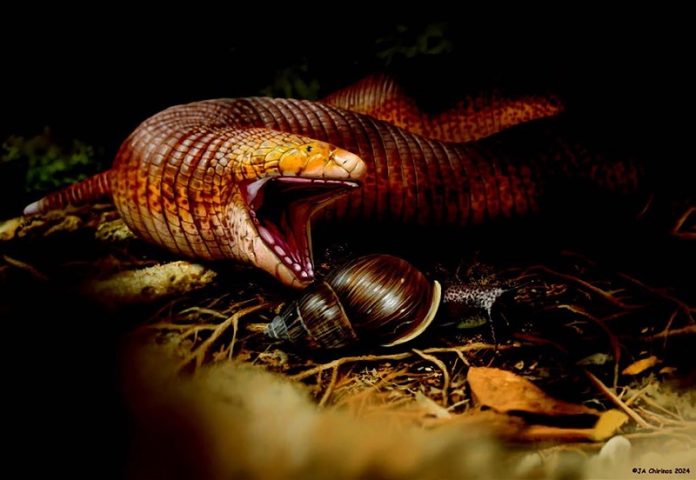
Scientists have unearthed a fascinating fossil in Tunisia—a giant worm lizard species with jaws strong enough to crack snail shells.
Named Terastiodontosaurus marcelosanchezi, this species is the largest ever discovered in the Amphisbaenia group, with a skull over five centimeters long.
The discovery sheds light on an ancient predator that likely roamed the surface, unlike its mostly underground relatives today.
The study, led by Professor Georgios L. Georgalis from the Polish Academy of Sciences, was published in the Zoological Journal of the Linnean Society.
The team included researchers from several institutions, including the Senckenberg Research Institute in Germany, the Institut des Sciences de l’Évolution de Montpellier in France, and the National Office of Mines in Tunisia.
Worm lizards, also known as Amphisbaenians, are reptiles with a worm-like appearance and unique abilities. Their rounded tails make them look like they have heads on both ends, allowing them to crawl forward and backward.
Most worm lizards live underground, using their narrow, flexible bodies to dig and navigate tight spaces.
However, Terastiodontosaurus marcelosanchezi breaks the mold. Its large size suggests it couldn’t have lived only in burrows. “This species was likely a surface dweller as well,” says Professor Georgalis. Its massive size, combined with powerful jaws, sets it apart from today’s worm lizards.
The fossil reveals extreme dental features, including a large tooth in the upper jaw, flat molars, and thick tooth enamel. These traits suggest the species specialized in eating snails, a diet that has been consistent for more than 56 million years.
“We know that modern checkerboard worm lizards crack open snail shells with their jaws,” explains Dr. Krister Smith from the Senckenberg Research Institute. “This fossil shows that their ancestors were already doing the same millions of years ago.”
The researchers used advanced micro-computed tomography to examine the fossil in detail. This imaging technique showed that the lizard had incredibly strong jaw muscles, likely enabling it to crush even the toughest snail shells with ease.
The large size of Terastiodontosaurus marcelosanchezi might be linked to the warmer climate of the Eocene epoch, when it lived. “If worm lizards could grow this large, it’s similar to how snakes like Titanoboa became massive in warmer prehistoric climates,” says Dr. Smith. While the new species isn’t as large as Titanoboa, it is much bigger than any of its worm lizard relatives.
Professor Georgalis compares the species to the giant sandworms in the Dune novels and films. “It’s easy to imagine this animal as a smaller version of those fictional creatures, with its powerful jaws and unusual body shape.”
This discovery not only reveals the existence of a giant worm lizard but also highlights its role as a specialist predator. For millions of years, this lineage has relied on its unique snail-cracking skills, adapting to environmental changes while maintaining its feeding strategy.



